After undergoing a couple long closures over the last couple years for upgrades to the trail and parking area, the Ha Ling Peak hike near Canmore is open to hikers and better than ever! This iconic hike is popular year-round, and it’s easy to see why. The summit of Ha Ling Peak towers 1100m over Canmore and the Bow Valley, but from the trailhead partway up the mountain the hike only requires less than 800m elevation gain. The trail is never particularly challenging, and recent upgrades to trail have carved out stairs in the steep stone section near the top, making this Kananaskis hike easier than ever. In this blog post I’ve made sure to highlight all the recent changes so you can make sure you’re prepared to hike Ha Ling Peak in 2023.
Ha Ling Peak was known for more than a century as “Chinaman’s Peak” after the Chinese cook who first climbed in 1896. It wasn’t until 1997 that it was changed to his actual name. As the story goes, Ha Ling was bet $50 that he couldn’t make it up the peak in under ten hours. The next morning he did exactly that and was back in time for lunch. People were doubtful of his accomplishment however, and couldn’t actually see the flag he claimed to have planted on the top. So the next day he took an even bigger flag and climbed the mountain all over again!
I highly recommend tackling this Canmore hike in the morning, just like Ha Ling did. This is one of the busiest and most popular hikes in the region, and the parking lot and trail get packed at midday. Ha Ling Peak is one of the very few peaks in the Rockies that sees sunrise and sunset hikers nearly every day of the year. No matter what time you hike, you won’t have the trail entirely to yourself, but Ha Ling Peak is such a great hike that it doesn’t really matter.
Continue reading this blog post for everything you need to know to experience the Ha Ling Peak hike in Kananaskis Country for yourself, including distance, elevation gain, how to get there, the best time to visit, and lots of photos of my experience.
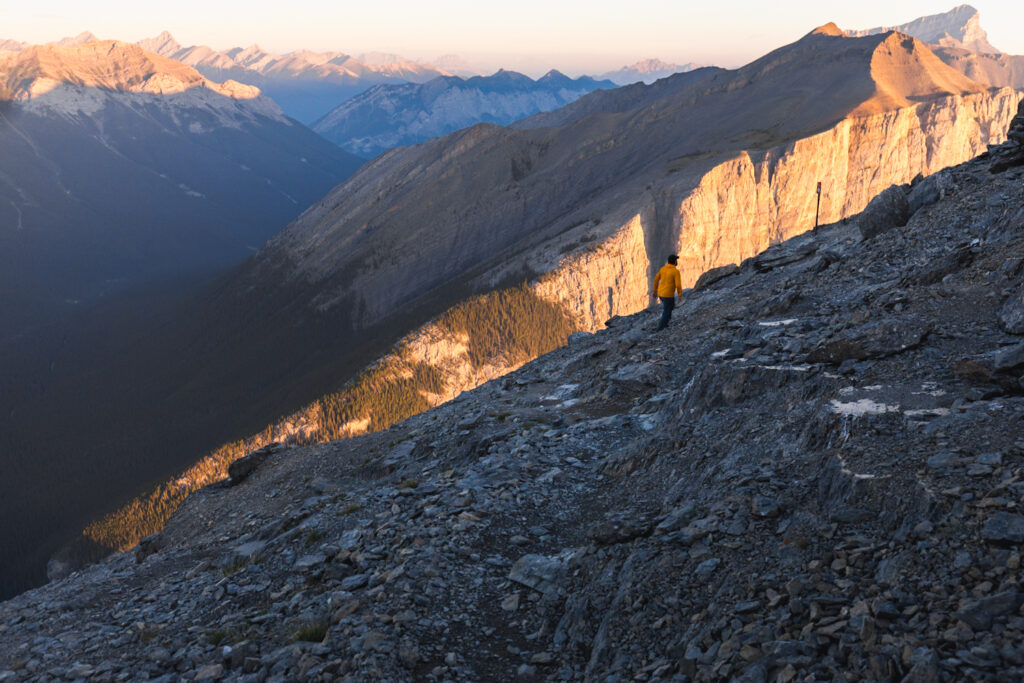
Note: The Ha Ling Peak hike is located in Kananaskis Country, meaning that a valid park pass is required. Day passes can only be purchased online and are per day per vehicle, but if you’re staying six days or longer, it’s more cost-effective to just buy an annual pass instead.
When hiking it’s important to avoid harmful practices such as disturbing plants or rock-stacking, or removing any natural object from flowers to rocks, as it’s important to leave the environment as natural as possible for the animals and for fellow hikers to enjoy in perpetuity. As many flowers as there are, there are few enough that if we all took one, then there wouldn’t be any left. Take only photos, leave only footprints.
If you haven’t heard of Leave No Trace principles, they’re also really essential to read up on before heading anywhere into the outdoors in general. Following these important principles basically means doing your best to leave beautiful places like Ha Ling Peak as good (if not better) than you found them, both for their preservation and for the enjoyment of other visitors.
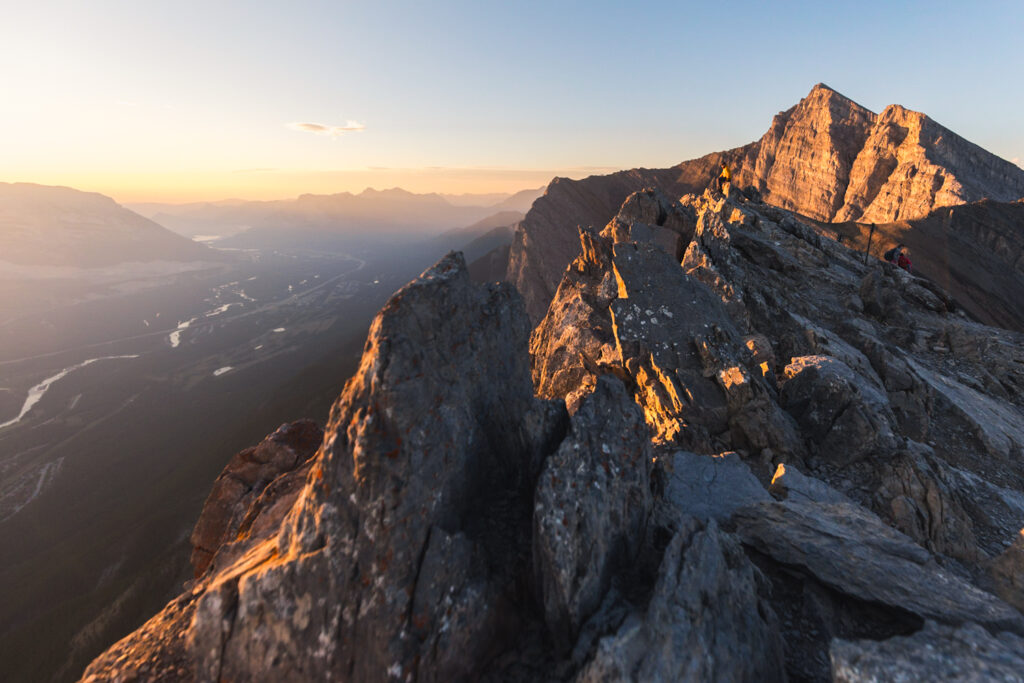
Ha Ling Peak Round Trip Details
Distance: 8 KM / 5 MI
Elevation Gain: 790 M / 2591 FT
Hiking Time: 3-4 HRS
Hiking & Safety Tips
- Prepare for the possibility of wildlife encounters. Bear spray is a must whenever travelling in bear country, as well as learning how to use it. Though your chance of an aggressive bear encounter is low, it is always better to be prepared with bear spray. Bear bells are proven to be an ineffective bear deterrent, and are actively discouraged by Parks Canada. The best way to let bears know you’re around is simply to use your voice. Make sure to keep a respectful distance from wildlife and never feed the animals. It may seem kind but it doesn’t just kill wildlife and put people in danger, it’s also in many cases illegal.
- Research current trail conditions and make sure you are well-informed about the route before you leave, and assess if it is within your capability. Be aware of what time it gets dark and check the weather forecast. Make sure to tell someone where you’re going and when you expect to return. Every year as more and more people try hiking for the first time, the number of rescues goes up. Being prepared is the best defense.
- Pack everything you need for a successful hike, including enough water and energy-rich snacks. Remember to pack out everything you pack in though – don’t expect to find a convenient garbage can halfway up the trail. Bring appropriate layers (remember you’ll warm up once you start hiking) and sun protection. Hiking poles may be helpful but are not required. In addition to not leaving any garbage on the trail yourself, I highly recommend bringing a garbage bag and collecting any trash that you do see on the trail. You’re guaranteed to make the hike up Ha Ling Peak a more enjoyable experience for the next person.
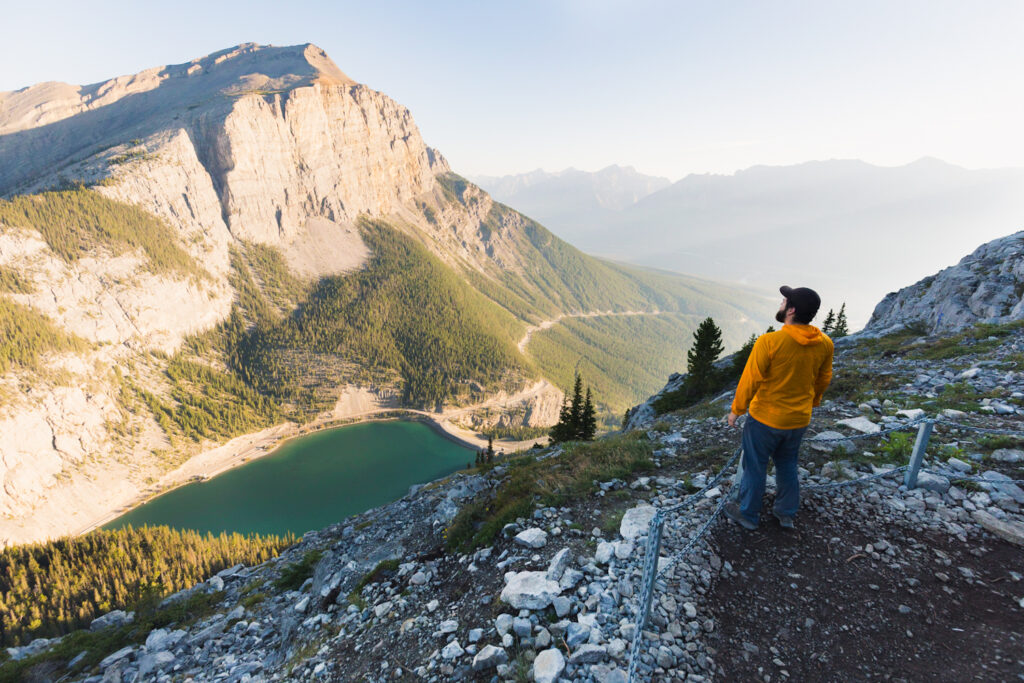
How to Get to Ha Ling Peak Trailhead
The Ha Ling Peak hike is one of the closest hikes to Canmore, only about twenty minutes from town. It’s forty minutes from Banff or an hour and a half from Calgary. From downtown Canmore, drive west onto 8 Ave and follow it south as it crosses the Bow River and eventually turn left when it reaches Three Sisters Drive. When Three Sisters Drive forks a couple minutes later, turn right onto Spray Lakes Road as the gravel road climbs up along the side of Mt Rundle and passes alongside two reservoirs. Look out for the large obvious parking area on the right side of the road – it’s impossible to miss.
Click here to open the exact trailhead location in Google Maps.
Hiking Ha Ling Peak
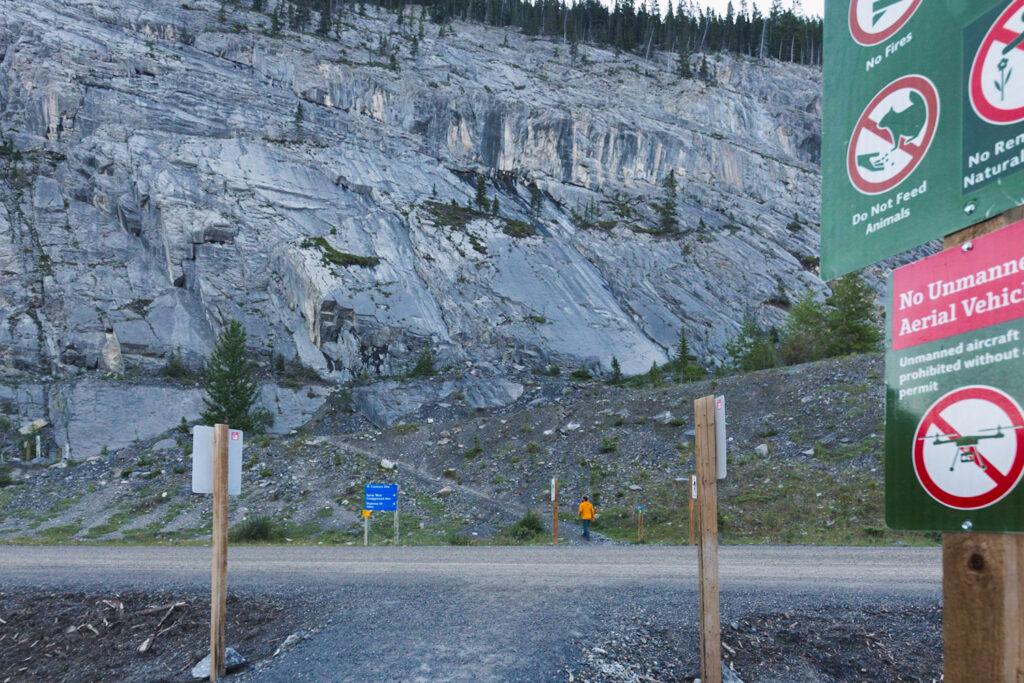
The trail up Ha Ling Peak is well-signed, and starts directly across from the parking area. The Ha Ling Peak parking area was closed for over a year as it was upgraded significantly in size.
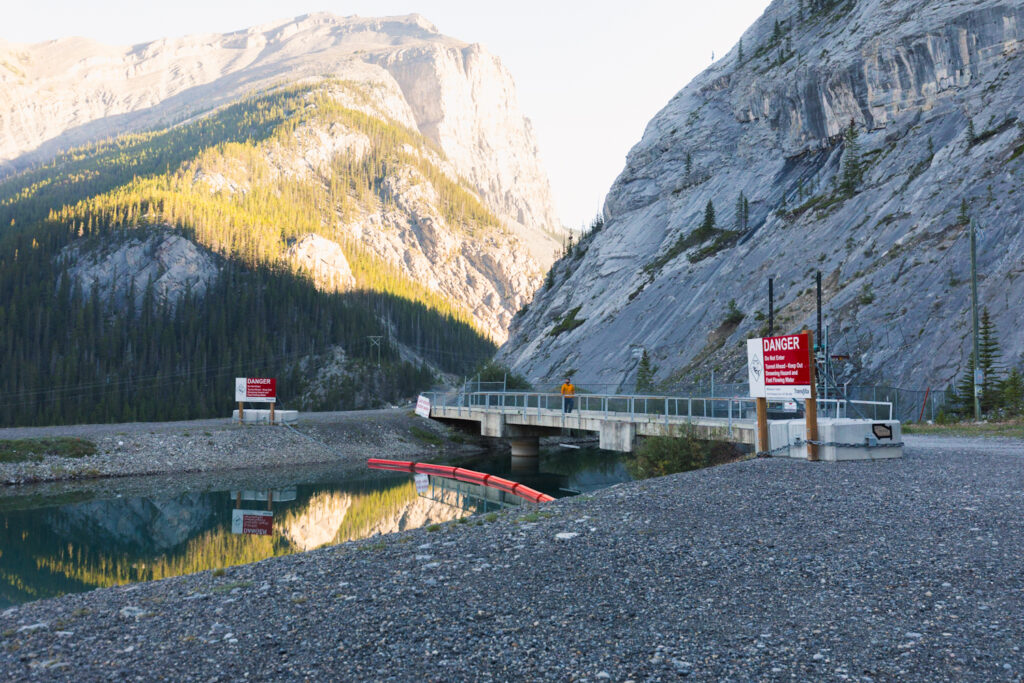
The trail crosses the canal, part of the network that provides Canmore its drinking water. Another iconic Canmore peak, the East End of Rundle (or EEOR) is visible in the background.
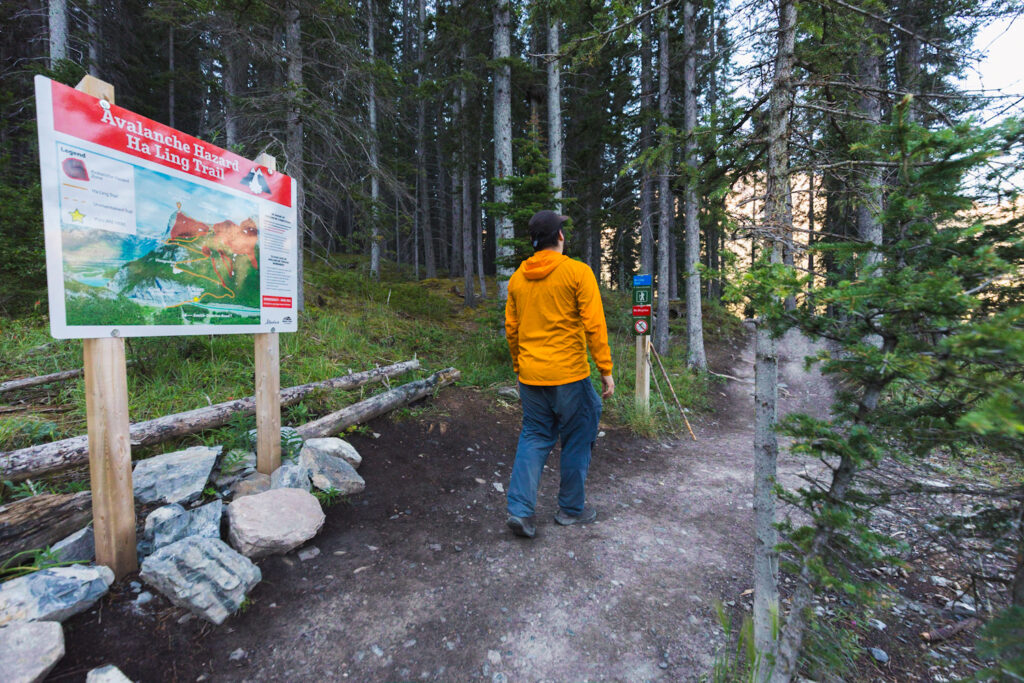
Starting up the Ha Ling Peak trail.
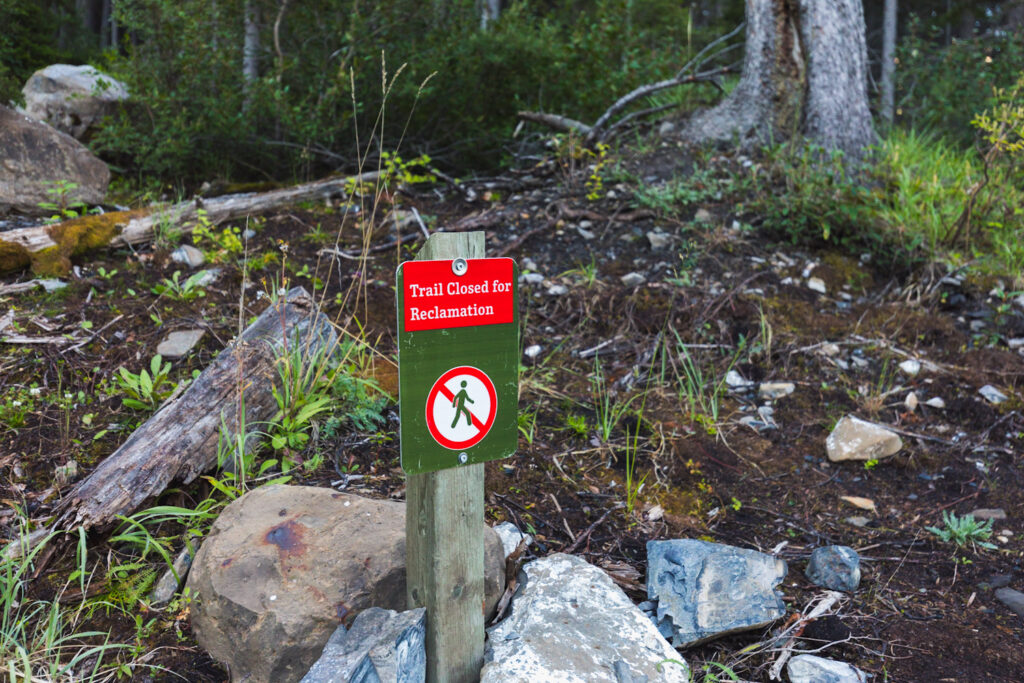
An older section of trail has been closed as it has been replaced with a superior trail up the mountain. Make sure to stay off the old trail.

The trail is fairly uninteresting as it switchbacks three times up towards a notable viewpoint. Think of an ‘M’ shape being made by the trail as it connects the start of the trail with the viewpoint via four trail sections with three sharp turns.

A slightly steeper (and potentially slick when wet) section has helpful chains installed.
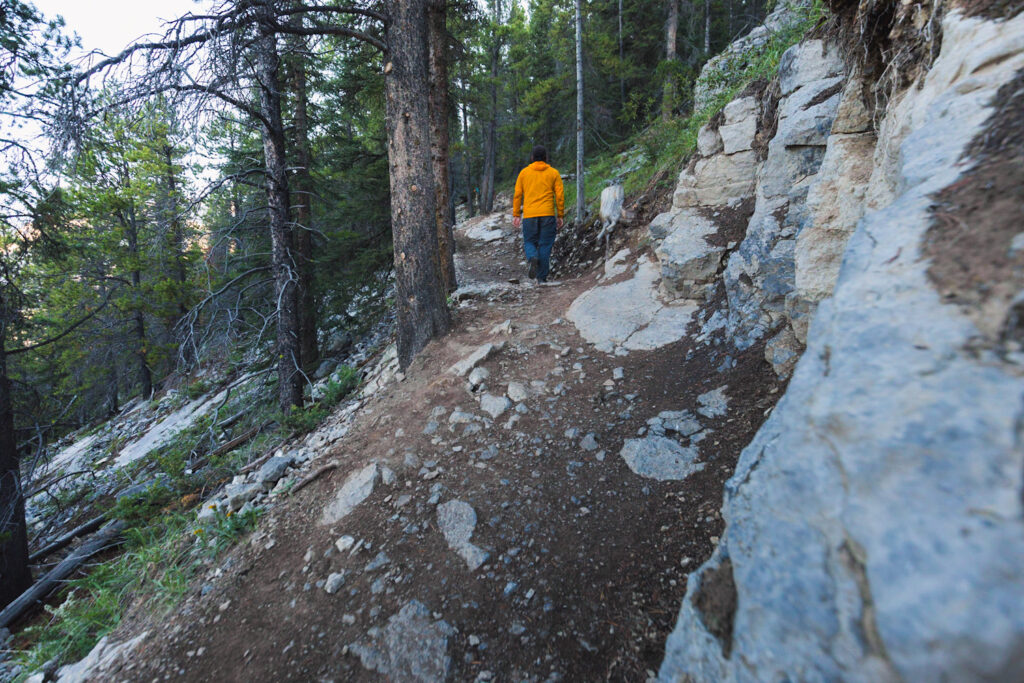
Approaching the viewpoint at the end of the switchbacks.

Approaching the viewpoint. The trail branches here, with the viewpoint on the left, and on the right the trail continues up Ha Ling Peak

Views of EEOR and White Man’s Pond below. Visible like a scar running up Mt Rundle is the road connecting the Ha Ling trailhead with Canmore.
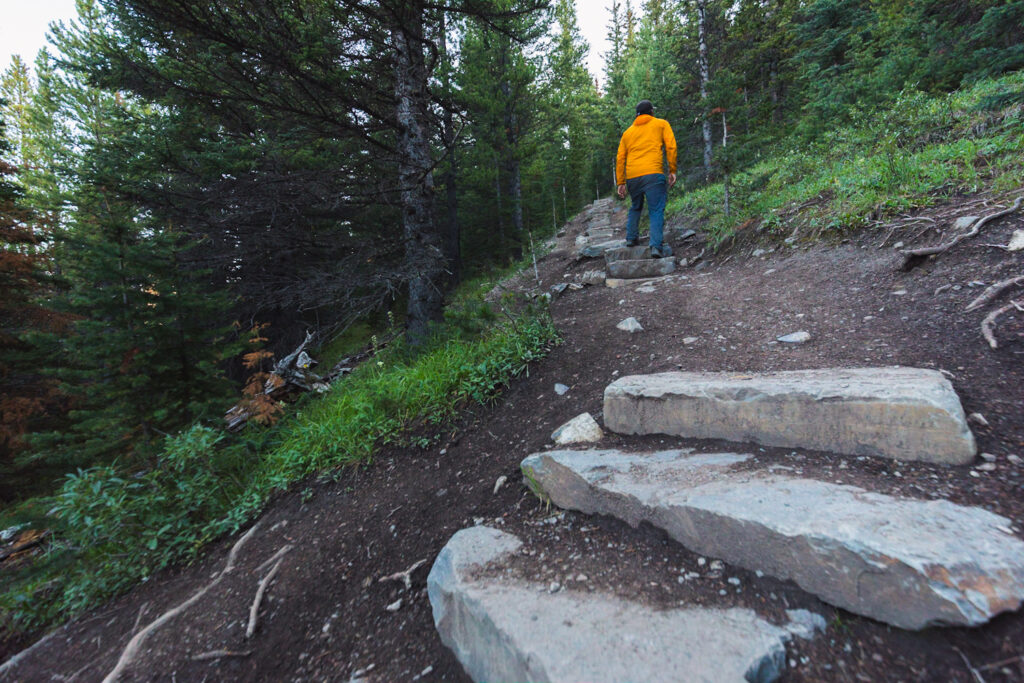
I don’t remember as many of these stone steps being present, so I think they’re a result of recent trail upgrades.

Because of the well-built trail, Ha Ling Peak is a popular hike even in the winter. It does cross a couple avalanche areas to be aware of and ice spikes are definitely necessary though if hiking in the winter.
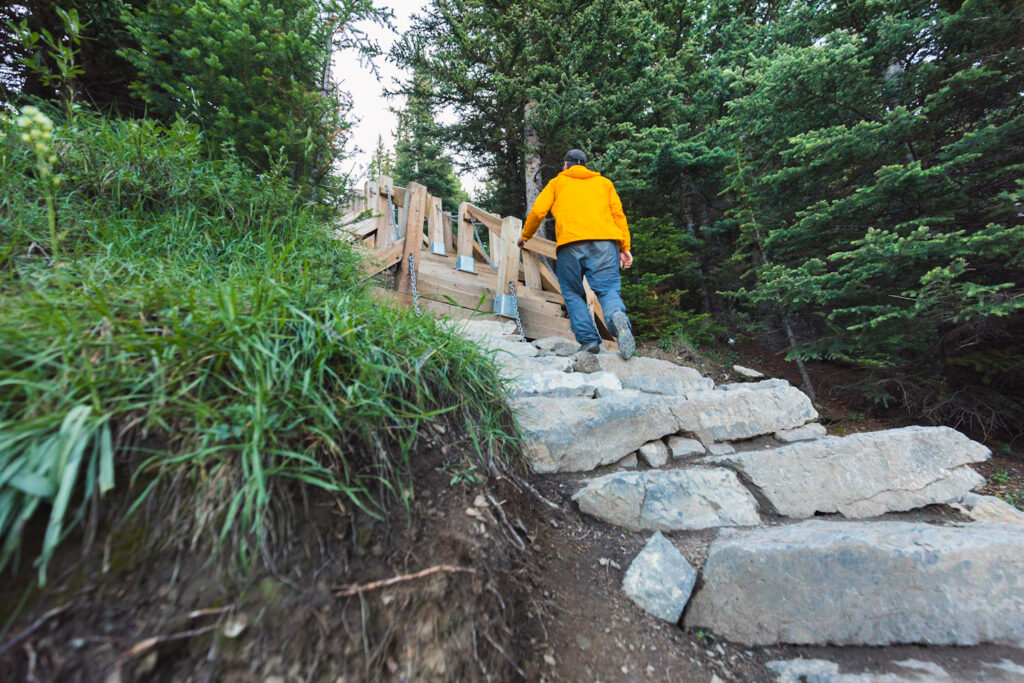
The first of three sets of wooden stairs. These things are tiring, but help to gain elevation quickly. Around this time the trail leaves the tree line exposing fantastic views of the valley.
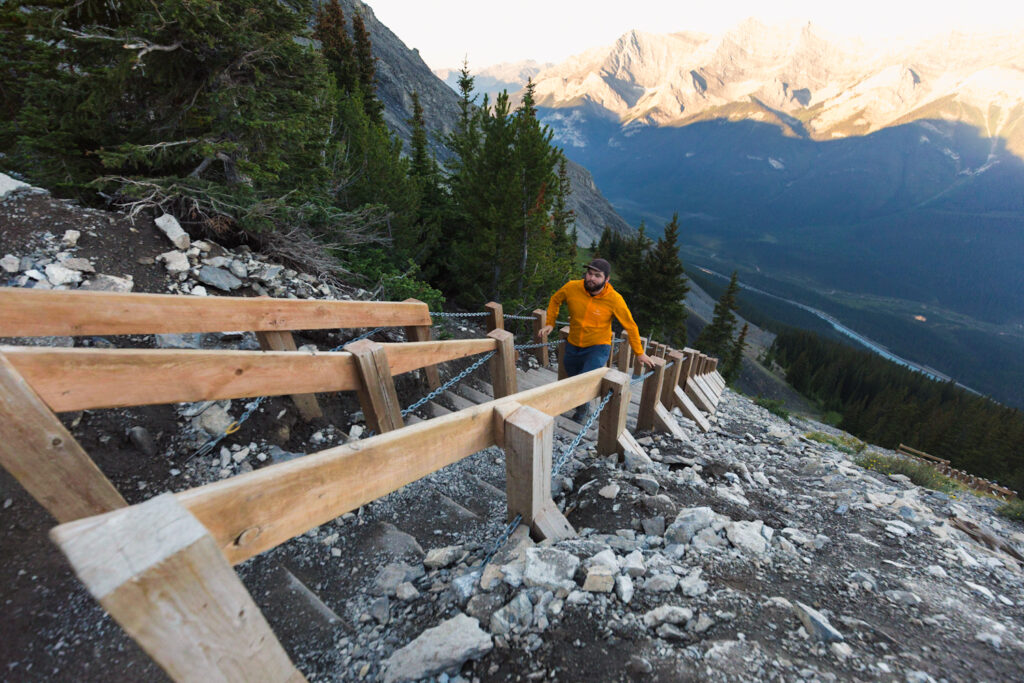
Energy is low as I pull myself up the last set of stairs.
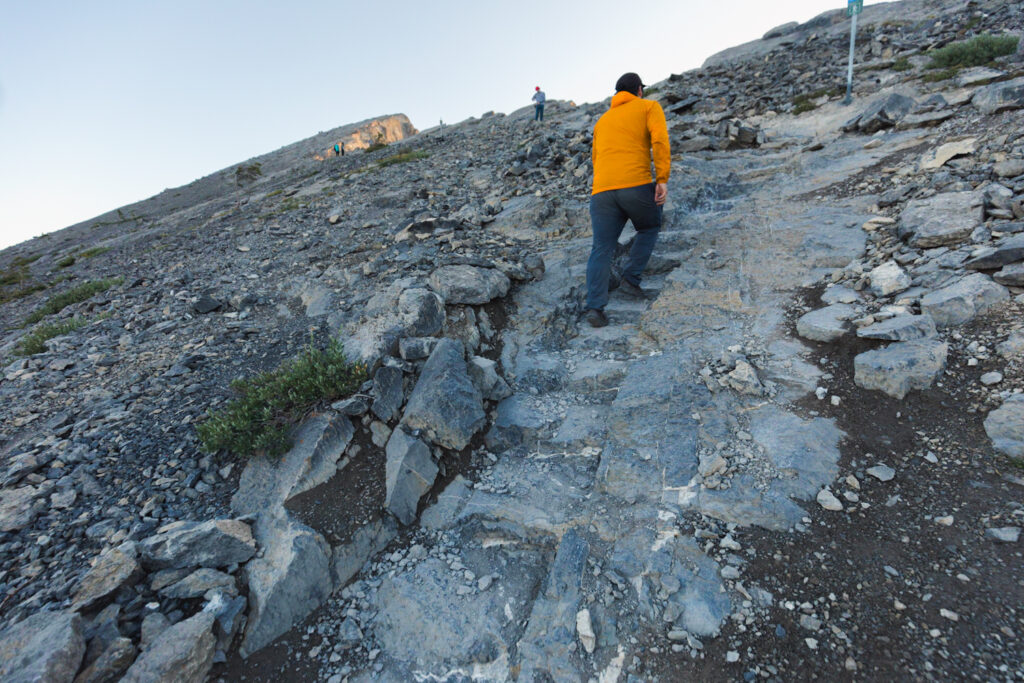
The summit is visible on the right. The rock here has recently had these stairs carved into it, making it a million times easier than the slippery slope that was here before. This is a major upgrade to the trail.
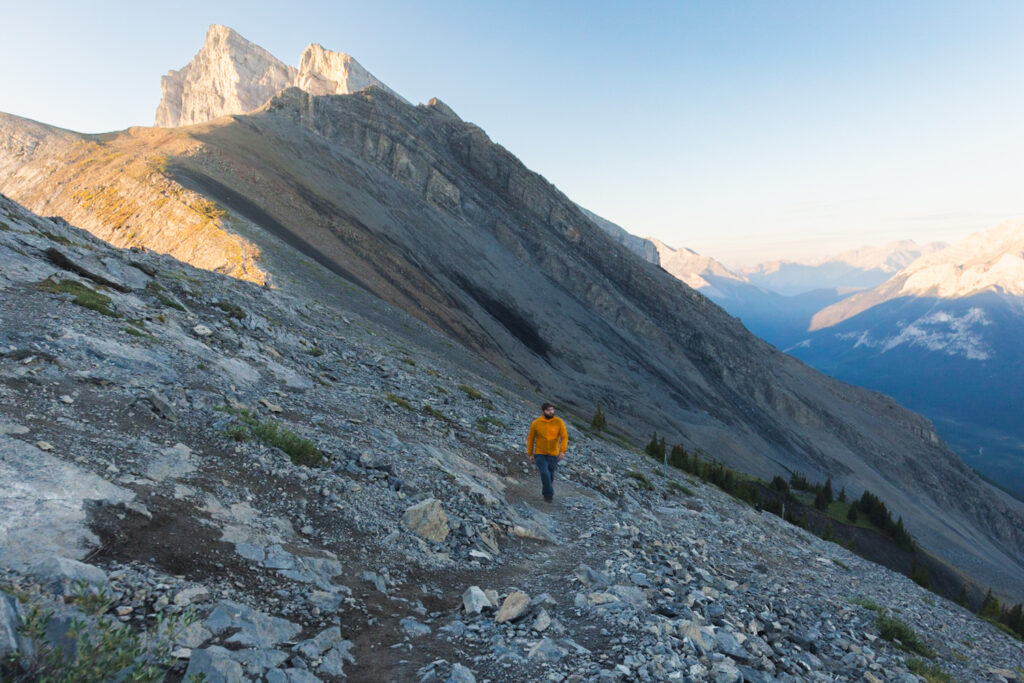
Visible at left is the saddle between Ha Ling Peak and Miner’s Peak. The maintained trail leads up to the saddle where I noticed a number of people decided to end their hike without going further.
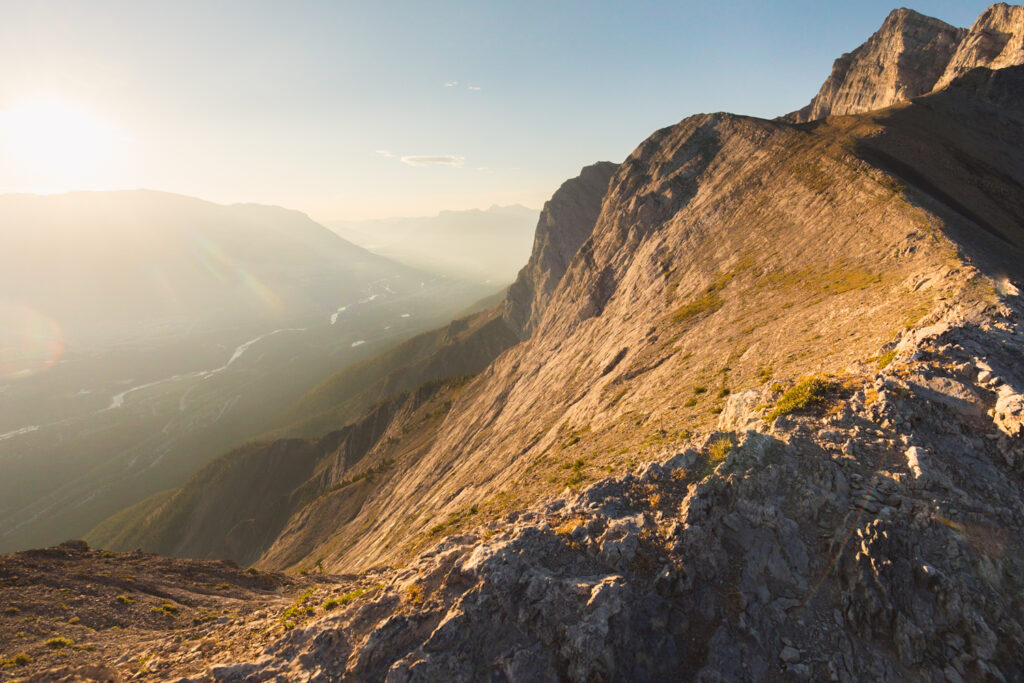
Incredible views from the saddle. Miner’s Peak is visible across the way.
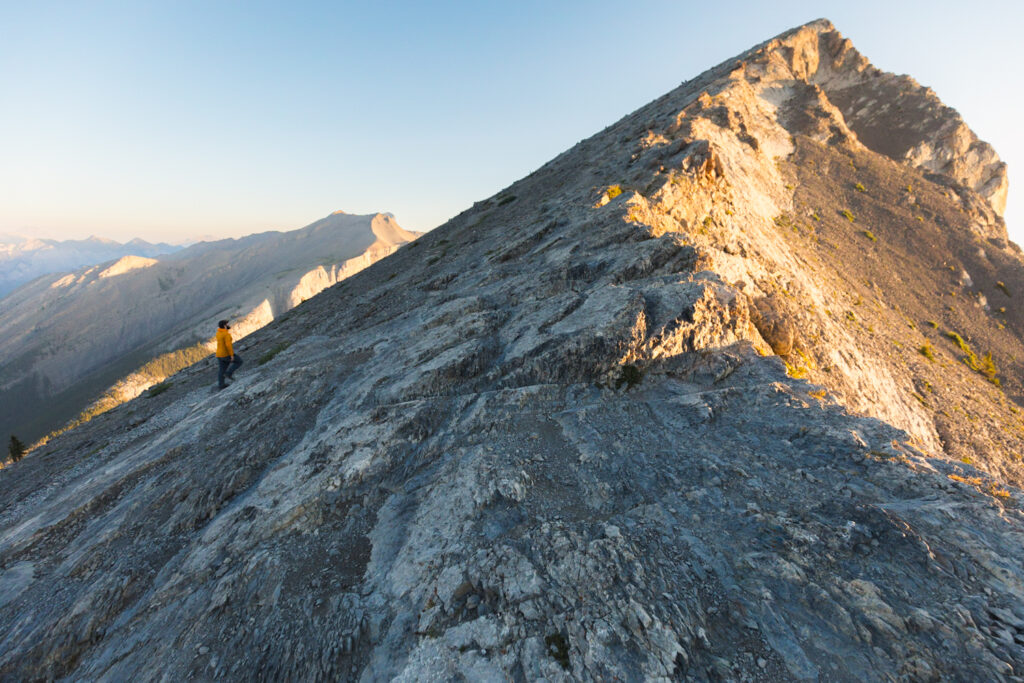
Continuing up from the saddle to the top of Ha Ling Peak. There aren’t any stairs carved in the rock after this point so it’s a little trickier, but still doable by most hikers.
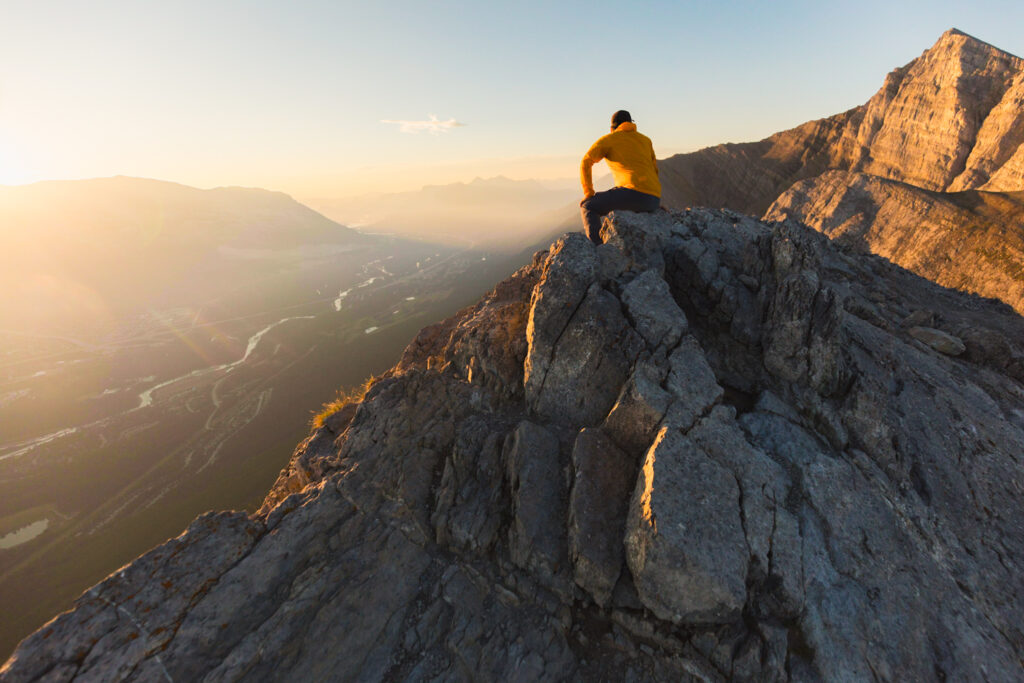
On top of Ha Ling Peak looking out over the Bow Valley below.
Recommended Hiking Gear



Water is a must whenever I’m hiking, especially if the sun is going to be out. My favourite water filter I’ve used is the Katadyn BeFree 0.6L, which unlike other water filters I’ve used packs up really small and lightweight. For hikes where I know there won’t be any readily available water sources along the way, I make sure to bring my own. The Hydrapak Stow 1L bottle is my go-to, for the same reason that it’s made of a soft plastic that folds up and doesn’t take up any more extra space than necessary in my pack. Finally, Aquatabs are another great option for purifying water, with one tablet being suitable for one litre of water. I previously used the Grayl water filter while travelling internationally, and though I found its hard body more convenient for day to day use and easier to drink from, it has a little too much bulk for my fast-and-light style of hiking.



The secret to all my photos of gorgeous sunset and sunrise mountaintop views? A lot of hiking in the dark. And let me speak from personal experience when I say that the last thing that you want to happen when hiking is to be caught in the dark without a headlamp. I used the Black Diamond Spot 400 for years and it worked great – until I lost it on top of a mountain somewhere. The only downside to it was having to worry about the batteries dying, though there’s also a slightly more expensive version that has a rechargeable battery. Nowadays I’m using the Petzl Actik Core, which is a bit pricier than the more budget-friendly Black Diamond, but is also brighter, more comfortable (in my opinion), and has a hybrid power system that is rechargeable but can also take AAA batteries if needed.
You won’t see me using trekking poles on shorter hikes often – but on long hikes and backpacking trips, as well as certain scrambles, they are an absolute lifesaver. I’ve invested in a high quality ultra-lightweight pair of MSR DynaLock Ascent carbon poles which, while pricey, I don’t regret one bit. If you’re not entirely sure how much use you’re going to get out of a pair of trekking poles, the best budget-friendly option would be the Trekology Trek Z 2.0. Amazon does sell a lot of cheaper Made in China-style trekking poles for cheaper, but these usually are much much heavier and not worth buying.
All the best and most long-lasting cables and power banks I’ve ever owned have been Anker. I once had a phone cable from them that lasted me over three years of daily use! That’s why I keep an Anker PowerCore Essential 20K power bank on me. Like many people I use my phone for a lot of stuff when hiking (checking in with family, using online maps, taking photos, flying my drone) so I like to be prepared for that low battery warning by having a backup power source on me just in case.



The only socks I ever buy for myself are from Darn Tough, and I almost always make sure to wear them when hiking. After years of having no problems only wearing these comfortable and rugged socks for hikes, I accidentally wore a pair of no-name socks on a hike last year and ended up with blisters on both feet. Safe to say I’m back to sticking with the Darn Tough. And the best part? They have a lifetime guarantee, meaning that if they ever wear out you can send them back for a brand new pair. For hiking footwear I go between a pair of lightweight approach shoes for quick and dirty mountain ascents or anything involving scrambling and more heavy-duty boots for longer treks. I’ve worn a couple different versions of the lightweight but super durable Arc’teryx Konseal FL 2 approach shoes for a few years now and am very impressed with the durability. I also really like the thick toecap that keeps me protected every time I stumble into a root or large rock. For longer, tougher, or muddier treks I rely on my LOWA Camino EVO GTX, which I find insanely comfortable and made of very high quality.



I wear my Ar’teryx Gamma Lightweight Pants on every single hike I go on, and on many days when I’m not hiking. After several years of abuse they are still holding together extraordinarily well, with only a few small holes from where I’ve fallen down and some slight stains from being repeatedly coated with mud. They’re lightweight, breathable, and super comfortable. For lightweight and breathable hiking tops I’m a big fan of both the Patagonia Capilene Shirt and the MEC Core Shirt. My Arc’teryx Squamish Hoody shows up in a lot of my photos. It’s super lightweight and packable, and does a great job of cutting the wind while also being pretty breathable. I also have an Arc’teryx Atom Hoody and Arc’teryx Beta LT that I pull out for cooler or wetter conditions.
I hope you enjoyed this guide to hiking Ha Ling Peak near Canmore! Feel free to leave any questions in the comment section below or to contact me directly via social media.

thanks alot of informaation